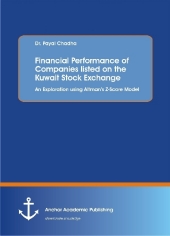 Neuerscheinungen 2016Stand: 2020-02-01 |
Schnellsuche
ISBN/Stichwort/Autor
|
Herderstraße 10
10625 Berlin
Tel.: 030 315 714 16
Fax 030 315 714 14
info@buchspektrum.de |

Payal Chadha
Financial Performance of Companies listed on the Kuwait Stock Exchange. An Exploration using Altmanīs Z-Score Model
2016. 92 S. 14 Abb. 220 mm
Verlag/Jahr: ANCHOR ACADEMIC PUBLISHING 2016
ISBN: 3-9606704-3-5 (3960670435)
Neue ISBN: 978-3-9606704-3-8 (9783960670438)
Preis und Lieferzeit: Bitte klicken
A quantitative method was used to explore the financial performance of the firms listed on the Kuwait Stock Exchange. The number of firms explored was 196 out of a possible 206 (two firms are subsidiaries of one of the firms and others are insurance firms excluded from this study). The listed firms were observed from 2009-2014 to understand their status in the market and the direction they were heading towards. The financial data were gathered from the published annual reports of the respective firms and the financial statements from the Kuwait Stock Exchange website. This exploration is a stepping-stone for potential investors by showing the most profitable sectors for investment and for future researchers to predict accurate bankruptcy rates in the State of Kuwait.
Text sample:
Chapter Research Instrument:
The researcher used the original Altman Z-score model for exploring the financial performance of the listed firms. However, for banks, the revised model of Altmanīs Z-score was used. Zmijewski score model was used to distinguish between distressed and non-distressed firms using the criterion.
Zmijewski Score 0 shows non-distress.
Currently, no bankruptcy laws are existent in Kuwait. Hence, the probit model of Zmijewski i.e. it maps the value to a probability enclosed between 0 and 1 is not applicable here.
Instrument Validation:
Validity is an essential contemplation in developing and evaluating tests (Park, 2012). According to the Standards for Educational and Psychological Testing (2002), validity "refers to the degree to which evidence and theory support the interpretations of test scores entailed by proposed uses of tests" (Park, 2012,p.54). Cronbach (1971) defined validity as "the accuracy of all the analysis of a test."(p.55). All of the above definitions relate validity to the suitability of the implications included in test score interpretations. Sireci (2007) explained the fundamental aspects of validity.
- Validity refers to the use of a test for a particular rationale (Park, 2012).
- Evaluating the usefulness and suitability of a test for a particular rationale requires several sources of proof.
- Adequate proof must be put ahead to defend the use of the test for that purpose.
- Evaluating test validity is a nonstop procedure.
Following this idea, this research discovers each resource of validity proof. The sources of validity proof identified are described as follows.
Predictive/criterion validity is applicable in this research. This measures the extent to which a tool can predict a future event of interest, i.e., the financial soundness of the firm or bankruptcy occurrence this is research. Both models, i.e., Altman Z-score and Zmijewski scores are validated by testing them on the sample of 196 companies to match the criterion scale mentioned.
Data Collection Procedures:
Resources and data needed for this research are secondary and gathered using the annual reports from the company websites and financial reports available on the Kuwait Stock Exchange website for the period 2009-2014. The purpose of choosing, this time frame, was to study the market after the financial crisis of 2008. Therefore, the researcher fulfilled the content validity criterion.
Data Analyses:
The quantitative method uses the data collected to calculate both Altman Z-score and Zmijewski score for the listed firms. These two sets of data scores will be tallied with the criterion scales for each of the models to predict their performance. This will be represented using annual pie charts to understand the status of the market in Kuwait.
Summary of Methodology:
The quantitative methodology uses the financial data from the annual reports of the listed companiesī websites and financial reports from the Kuwait Stock Exchange website for the application of Altman Z-score model and Zmijewski score model. Both of them predict the performance and bankruptcy rate of the two sets of data using the predefined criterion scales for each of the models. The subsequent chapter will dig into further details.


